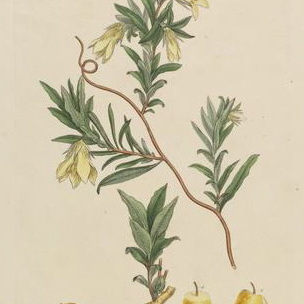Habit: shrubby, rhizomatous to 0.5 m, eventually scandent; new shoots densely silky hairy. Leaves: adult leaves alternate, narrow ovate, 20–40 mm long, 6–14 mm wide; margins undulate, sinuate; silky hairy on both surfaces, petioles 1–4 mm. Inflorescences are single or paired bisexual flowers; stalks 5–12 mm long, hairy, angular, down turned but not nodding, bracts sepaline, caduceus. Sepals unequal, spreading, 6–10 mm long, yellow tinged pink, almost linear. Petals 16–20 mm long, clawed, briefly connivent at base, canary yellow, becoming pinker with age and sex phase change, apices hairy, not recurving. Stamens free, filaments white tapering, longer than anthers; anthers yellow ovoid; dehiscing through apical slits, pollen pink, mauve. Pistil with vestigial nectary; ovary silky hairy; short style, stigma knobby. Fruit bilocular indehiscent 20–28 mm long, berry-like, obovate to oblong in shape, very hairy with seeds in individual cells surrounded by a papery liner in two rows in each chamber. Seeds numerous, red-brown, discoidal, seed surface lightly striate. Peak flowering mainly summer.
More
A small woody plant. It has twining branches. The stems can be 3-4 m long. The leaves are thin and sword shaped. They are 3-5 cm long. The edges can be wavy. The upper surface is dull green and the underneath is paler with prominent midribs. The flowers are large and greenish-yellow then turning purple. They are bell shaped and hang downwards. They are 2-5 cm across. Flower stalks are slender and 2.5 cm long. The fruit is 4 cm long and 1 cm wide and green turning yellow when ripe. The fruit are edible.
The ripe fruit are eaten. They have a flavour like stewed apples. The unripe fruit need to be cooked. For eating fresh the fruit should be very ripe and soft. They can be cooked. It can be used in baked desserts, pies, tarts, muffins and scones.
Plants can be grown from seed or cuttings. The fresh seed with the pulp removed are sown shallowly. They take 8-10 weeks to germinate. Stored seed may take a year to germinate. Cuttings strike easily. Semi ripe cuttings 10-12 cm long with a heel are planted in warm soil. Young stems can be layered to form roots.

